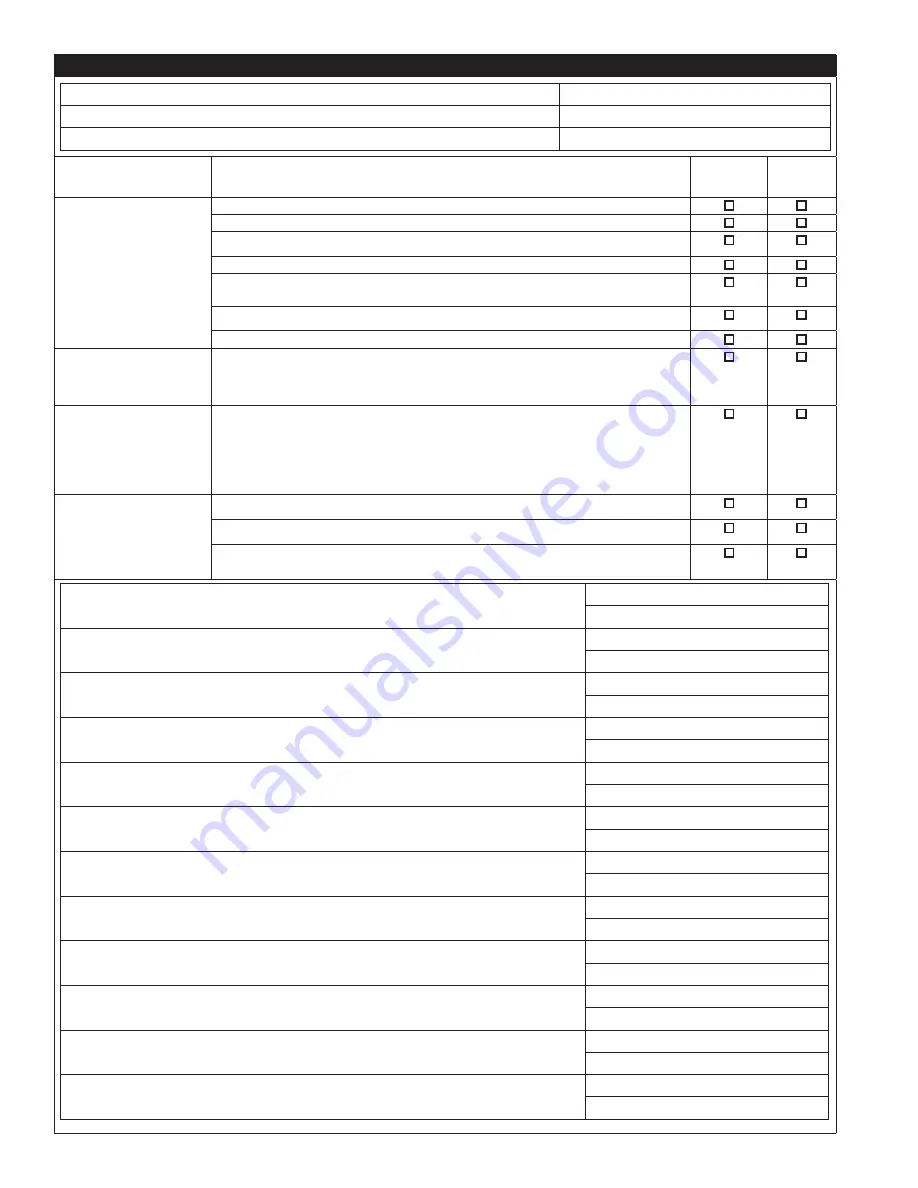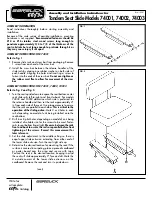
12
Table 2 – Inspection and Maintenance Log
Serial Number(s):
Date Purchased:
Model Number:
Date of First Use:
Inspected By:
Inspection Date:
Component:
Inspection:
Authorized
Person or
Rescuer
Competent
Person
SRL
(Figure 11)
Inspect for loose bolts and bent or damaged parts.
Inspect Housing (A) for distortion, cracks, or other damage.
Inspect the Swivel Eye (B) for distortion, cracks, or other damage. The Swivel Eye should be attached
securely to the SRL, but should pivot freely.
The Lifeline (C) should pull out and retract fully without hesitation or creating a slack line condition.
Ensure device locks up when lifeline is jerked sharply. Lockup should be positive with no slipping.
The labels must be present and fully legible (labels are illustrated and defined on the back pages of
this instruction).
Look for signs of corrosion on the entire unit.
Swivel Snap Hook & Impact
Indicator
(Figure 12)
Inspect the Swivel Snap Hook for signs of damage, corrosion, and working condition. Swivel should
rotate freely. Inspect the Impact Indicator. If the Red Band (A) is displayed (Indicated Mode), impact
loading has occurred and the SRL must be removed from service and inspected. Do not attempt to
reset the Impact Indicator. Return the SRL to an authorized service center for resetting. NOTE: The
Swivel will not turn freely when the Impact Indicator is in Indicated Mode.
Wire Rope Lifeline
(Figure 13)
Inspect wire rope for cuts, kinks (A), broken wires (B), bird-caging (C), welding splatter, (D)
corrosion, chemical contact areas, or severely abraded areas. Slide the cable bumper up and inspect
ferrules for cracks or damage and inspect the wire rope for corrosion and broken wires. Replace the
lifeline if there are six or more randomly distributed broken wires in one lay, or three or more broken
wires in one strand in one lay. A “lay” of wire rope is the length of wire rope it takes for a strand (the
larger groups of wires) to complete one revolution or twist along the rope. Replace the lifeline if there
are any broken wires within 1 inch (25 mm) of the ferrules. Replace the lifeline if the Reserve Lifeline
Band is pulled out of the SRL and is visible.
Retrieval Integral Rescue Hand
Crank
(Figure 14)
Inspect the Crank Arm (A) for distortion or other damage. Ensure that the Retrieval Handle (B) can be
folded out and secured in the cranking position.
Ensure the Retrieval Shift Knob (C) can be pulled out to the unlocked position and then released,
locking the Crank Arm in both the engaged and disengaged positions.
Test the retrieval feature for proper operation by raising and lowering a test weight of at least 75 lbs
(34 kg). When the Retrieval Handle is released, the weight should not move and the Retrieval Handle
should remain in position (no movement). A ‘clicking’ sound should be audible when raising the load.
Corrective Action/Maintenance:
Approved By:
Date:
Corrective Action/Maintenance:
Approved By:
Date:
Corrective Action/Maintenance:
Approved By:
Date:
Corrective Action/Maintenance:
Approved By:
Date:
Corrective Action/Maintenance:
Approved By:
Date:
Corrective Action/Maintenance:
Approved By:
Date:
Corrective Action/Maintenance:
Approved By:
Date:
Corrective Action/Maintenance:
Approved By:
Date:
Corrective Action/Maintenance:
Approved By:
Date:
Corrective Action/Maintenance:
Approved By:
Date:
Corrective Action/Maintenance:
Approved By:
Date:
Corrective Action/Maintenance:
Approved By:
Date:
Summary of Contents for DBI SALA Sealed-Blok 3400828
Page 3: ...3 6 7 A B A B A B C A C B C D C B A B C D E...
Page 4: ...4 8 1 2 3...
Page 5: ...5 9 1 2 3 4 5A 5B 10 11 12 13 B B A A C C A D C B A 14 A B C D...
Page 67: ...67 5 3 Capital Safety 5 4 Sealed Blok DBI SALA 6 0 6 1 6 2 6 3...
Page 68: ...68 2 SRL 11 A 12 13 A B C D 25 1 14 A B C 34 75...
Page 78: ......













































